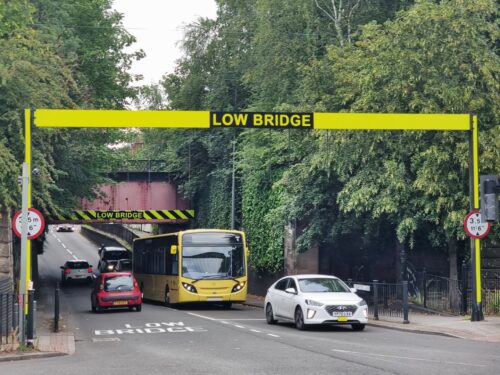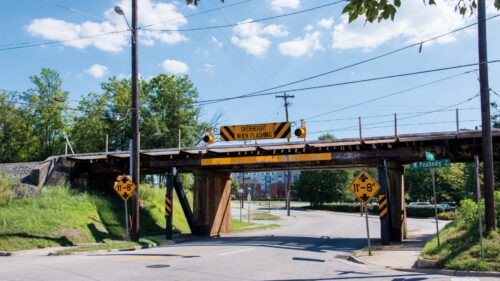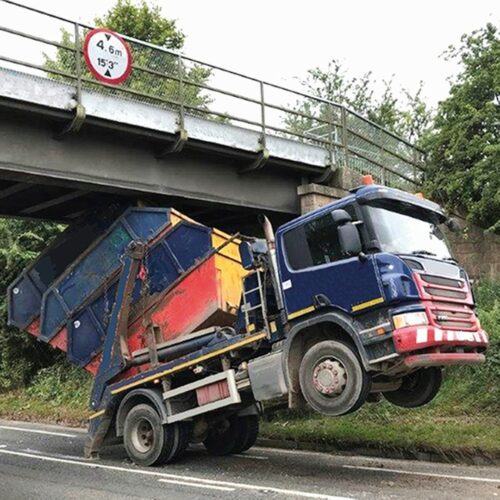
Jonathan Welch considers the issue of bridge-related accidents and wonders what more the industry can do to prevent them
We’ve all seen the videos online of people hitting bridges with vans and trucks, and to a thankful lesser extent buses. We’ve probably all laughed at their stupidity as someone drives a Luton van under a bridge barely high enough for a standard Transit. “How did they manage that?” we ask, from the safety of our chair, separated from reality by our screen. And yet, there but for the grace of God go we all. It’s easy to surmise that some, maybe even many, of those featured on a myriad of YouTube channels didn’t take the time to check their vehicle height or aren’t used to driving tall (often rental) vans. But it’s important to recognise too that some of them are professional drivers, people who, you’d believe, should know better. From the safety and comfort of an armchair, it’s easy to say that, and yet I’m sure we all recognise that it only takes a moment to get it wrong. In our case, whilst truck and van drivers might be able to get away with nothing more than some damaged metal and damaged pride, for us there is the potential, a significant potential, for the outcome to be far, far worse.Recent events in Manchester show that; in two days, two bridge strikes occurred, and whilst one involved a training bus scraping beneath a low bridge, the second involved a bus with passengers aboard passing beneath a bridge at speed, and being de-roofed as a result. It’s an incident that will stay with those involved for a long time; a number of passengers sustained significant injuries.
Training
The HGV sector has taken a number of steps to address the issue, and says pro-active prevention is key. RHA Head of Technical Aaron Peters comments: “Bridge strikes are a preventable hazard that continue to cause disruption and damage infrastructure. The HGV sector has made strides through structured training and height awareness campaigns, but the challenge remains sector-wide. PSV operators can benefit from HGV operator experience in proactive driver education and route planning, while contributing their own strengths in passenger safety. Whilst each sector has differing issues, the fundamentals are similar. At the RHA, we believe that consistent messaging, collaboration and shared accountability across the entirety of the road transport and commercial vehicle space are all essential to driving down incidents and raising awareness.”
It’s an issue that as an industry, we really need to get to grips with, but sometimes it’s hard to see what the right solution might be. There’s a part of me that really wants to say ‘no excuses. The buck stops with the driver.’ And to an extent, it’s true. The driver is the last line of defence. The driver is the one looking out of the window. The driver is the one being paid to drive safely. And it’s one of the cornerstones of the driver’s job to make sure they know their vehicle’s size. But besides sounding very cruel towards those drivers who have made a genuine mistake which could affect not only their career but their physical and mental health, especially if the consequences are at the severe end of the scale, I’m not sure that’s the whole answer. In fact, it’s not. It’s far from it.

Mitigation
It’s impossible to take away the fact that ultimately, the driver is behind the wheel at the time of the accident, but there are many things that we can do to reduce the chance of them making the possibly fatal mistake in the first place, and ‘it’s the driver’s responsibility’ doesn’t take away everyone else’s to play their part. Speaking from a regulatory perspective, former Traffic Commissioner and founder of her own consultancy and training company Beverley Bell reminds us: “The responsibility for avoiding bridge strikes sits with both the operator of the vehicle and the driver. It is always a completely avoidable occurrence but one that happens all too often, causing damage, disruption but most importantly, personal injury and tragically sometimes loss of life. All bridge strikes are serious, but this is particularly the case in the PSV world, where the most precious cargo of all is being carried and the protection of passenger safety must be the overriding focus.”
The situation is clearly very different for coach operators than for bus operators, whose vehicles follow relatively fixed and predictable trajectories day in, day out. But that can also be part of the problem. It would be easy to speculate in the recent Manchester case that the driver had turned onto the road under the bridge (an aquaduct, in fact) because they had been driving a single-deck route which did exactly that previously. Is there more that operators can do in this regard?
Probably, yes, though it’s likely not as simple and clear cut as that when other requirements are factored in and schedulers are trying to ensure the most efficient use of drivers. Even then what if a driver were working as overtime after their shift? Still, it’s something that we could give more consideration to.
Can technology help? Definitely. We’re already able to take advantage of new technology, whether that be online mapping and street views or in-cab devices to warn of low bridges. Companies such as Ticketer and Transmach have joined the game with low bridge warnings based on GPS to help alert drivers, though I’ve heard some staff worry that there are still too many ‘false warnings’ on routes which pass near to, but not under, low bridges; that, of course, it the perfect storm. A driver ignoring a warning, and at the same time confusing one route for another.
However, TransMach director Minesh Vandra says the problem is being solved: “TransMach’s technology utilises highly accurate device-based GPS, polygonal geofencing and GMS-supported (Google Mobile Services) location mapping to deliver precise low bridge alerts,” he explained. “With both audible and visual warnings activated well before a hazard is reached, drivers stay fully informed and protected without the risk of false alarms. This feature comes as standard with our latest 5G-enabled TM700 ETM.”
For coach operators, the risks are different, and for many will be broadly similar to those faced by HGV operators. Unfamiliar territory, unexpected diversions, and a brief moment of inattention. At least for coach drivers, their vehicle’s dimensions don’t change, unlike a HGV with different trailers. Nonetheless, the consequences can be equally serious, though recent evidence points to the bus sector as being the hotbed for the problem. Hi-tech solutions are of course available for coaches too, but there’s also the low-tech approach of a truckers’ atlas that shouldn’t be forgotten, with warnings of low bridges included.
It’s also worth noting the speed at which new warning signs were erected after the recent Manchester incident. Google Streetview images show that the chains suspended from a bar on the approach to the bridge were missing, and that signs could have been more easily visible prior to the collision. In the aftermath, new signs were installed, as well as painted warnings on the road. I’m not sure that the often-suggested mitigation of a stout bar before the bridge is the right answer, though, given that although it might protect the structure, its effect on a double-deck bus could be equally catastrophic. Nonetheless, at a time when cash is tight for highways authorities, it’s still right to ask what more can and should be done. It’s hard to lay blame solely at their door, but when there are clear deficiencies then there are likely to be some tough questions to answer if the worst happens.

If it happens?
A case which featured in our Legal News pages earlier this year shows that even if an operator puts systems in place to mitigate, a bridge strike can still occur. If the worst does happen, what must an operator do next?
In the immediate aftermath, thoughts will rightly be to look after passengers who might be injured or suffering from shock. A second immediate consideration of which drivers must be aware is that where the bridge carries a railway, it is imperative to inform the relevant railway authority immediately. Damage to the bridge could result in a far larger catastrophe should a train be approaching; drivers should look for the information plate attached to the bridge, and use the emergency number provided. Once the immediate aftermath has been dealt with, the regulatory process needs to be followed, as Beverley Bell explains: “Operators must report a bridge strike
to the Office of the Traffic Commissioner within 28 days and send an in-depth investigation pack to explain why it has occurred and what they are going to do to make sure it doesn’t happen again.
“The starting point for Traffic Commissioners is to call the operator to a preliminary hearing or, to a public inquiry, which can be a very uncomfortable experience. However, this is not as uncomfortable as having to face the families of those victims who have been injured or even or sitting in the dock, defending a criminal trial for causing serious injury or death by careless driving. The stakes are too high to not do all you can to prevent bridge strikes happening in the first place. Your driver will be called to a driver conduct hearing and the Traffic Commissioner’s starting point is to have their vocational licence suspended for a period of six months.
“You can see that this matter is taken very seriously, and we must all do everything we can to stop these senseless incidents happening in the first place.” As an industry, it’s imperative on all of us to do our bit. As a driver, vigilance and care must be the watchwords, whilst operators must not forget that they too can play their part in helping to minimise the risk of errors which could lead to a bridge strike. Do you know your height?

